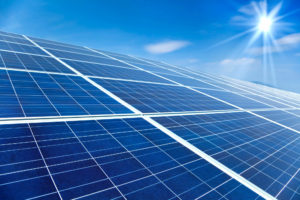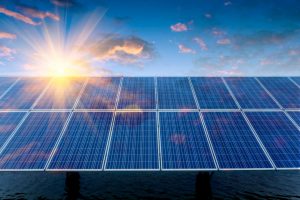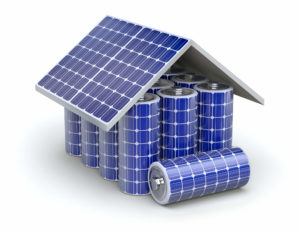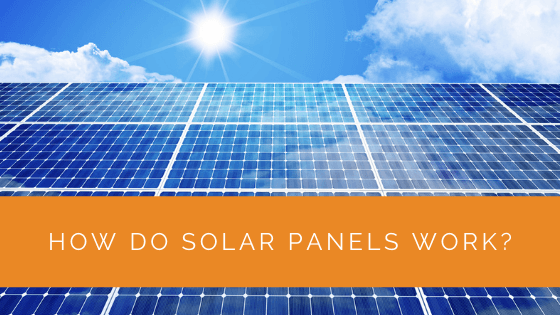Solar is perhaps the most abundant source of energy on earth. Did you know that the amount of sunlight that hits the earth in 90 minutes is enough to satisfy the entire planet’s energy consumption for one year?
Given that the sun never runs out, it is the ultimate source of renewable energy. With the current climate crisis and the need to minimize our reliance on fossil fuels, solar is being viewed as the most viable alternative energy resource.
With the costs of solar panels reducing and solar technology improving each year, more and more US households are embracing and adopting solar energy.
While you might already know that solar or photovoltaic (PV) panels convert sunlight into usable electricity, you might wonder how exactly they work and how they achieve this process. The purpose of this article is to demystify the science behind solar power.
Contents
- 1 Key Takeaways
- 2 How Do Solar Panels Work?
- 3 What Is Solar Energy?
- 4 What Is Photovoltaics?
- 5 What Equipment Is Required for a Solar Panel System?
- 6 How Does Net Metering Work?
- 7 Do Solar Panels Work on Cloudy Days?
- 8 Case Study: Optimizing Residential Energy Use with Solar Panels
- 9 Expert Insights From Our Solar Panel Installers About How Do Solar Panels Work
- 10 Experience Solar Excellence with Us!
- 11 Conclusion
Key Takeaways
- Solar panels work by absorbing sunlight through photovoltaic cells, converting it into direct current (DC) power, which is then transformed into alternating current (AC) power using inverters for use in homes.
- Solar energy systems remain connected to the traditional electricity grid, allowing excess energy to be sent to the grid during the day and drawn from it at night.
- Net metering credits solar energy system owners for surplus power they contribute to the grid, potentially eliminating electric bills or even earning compensation for excess energy. Solar panels can still generate power on cloudy days and with indirect or reflected sunlight.
How Do Solar Panels Work?
Solar panels work by absorbing light from the sun using photovoltaic cells generating direct current (DC) power which is then converted into alternating current (AC) power using inverter technology.
This usable AC energy then flows through your home’s breaker panel, where it is distributed throughout your home.
The science behind the production of solar energy is based on the photovoltaic effect. This is the process through which certain semiconductor materials produce electricity when exposed to light.
The process of solar power production entails four basic steps:

Step 1. Solar Panels Capture Sunlight
Solar panels are made up of many smaller units, known as photovoltaic cells. These cells are sandwiched between layers of semiconducting materials such as silicone.
When photons (particles of light) hit the silicon photovoltaic solar cells, electrons are knocked off from their atoms generating DC electricity.
However, since DC flows in large amounts, it is not appropriate for domestic use, for example, in homes. It needs to be converted into usable alternating current (AC) electricity, which leads us to the next step.
Step 2. Inverters Convert Solar Energy to Useful Electricity
Inverters are special pieces of solar equipment used to convert DC electricity to AC electricity, which is much safer to use at home.
Depending on your solar system, it may come with one inverter for the whole system, also known as a string inverter, or it may have microinverters connected to each solar panel.
Step 3. Solar Electricity Is Used in the Home
The AC electricity then runs through your net meter and is distributed throughout your home, ready to power up your home and appliances.
One thing to note about installing solar energy systems is that you will still be connected to the traditional electricity grid. This means that if the energy produced by your solar system isn’t enough to meet your requirements, you can still draw more from it when needed.
Step 4. Leftover Solar Electricity Goes to the Grid
It is important to remain connected to the traditional power grid even after installing solar. During the day, your solar system can produce a full day’s worth of energy. And since most people don’t require a lot of energy during the day, there will often be excess energy in the system.
Remaining connected to the power grid allows you to trade-off this excess energy for traditional power to use at night when your solar system isn’t producing energy.
You send any excess energy produced by your system to the grid for the power company to use.
What Is Solar Energy?
Solar energy refers to the radiant light and heat produced by the sun that can be harnessed using a range of technologies, including:
- Photovoltaic cells which convert the light into electricity
- Solar thermal energy technology which utilizes heat from the sun to heat water or produce steam
- Artificial photosynthesis, which involves absorbing and storing energy from sunlight in the chemical bonds of fuels

What Is Photovoltaics?
Photovoltaics refers to the direct conversion of light into electricity on an atomic level through the use of semiconducting materials, such as silicone, that manifest the photovoltaic effect.
The photovoltaic effect is a phenomenon studied in physics, electrochemistry, and photochemistry.
The term was first mentioned in 1839 by a French physicist who discovered that certain materials could produce varying amounts of electric current when exposed to light.
The photovoltaic effect causes these materials to absorb photons or light particles that knock off electrons from their atoms. These free electrons, when captured, flow as an electric current.
What Equipment Is Required for a Solar Panel System?
Solar Panels
When you think of solar power, solar panels are perhaps the first things that come to mind. They are the most important component of a solar panel system. Solar panels consist of many solar cells that are responsible for converting sunlight into electricity.
There are two main types of solar panels: monocrystalline and polycrystalline solar panels when it comes to residential solar energy systems.
While both types of panels serve the same purpose, monocrystalline panels are more efficient and economical than the polycrystalline type.
Solar Inverter
As discussed earlier, solar panels produce direct current (DC), which isn’t suitable for domestic use. It needs to be converted into alternating current (AC). This is where inverters come in.
Inverters regulate and adjust the energy produced by solar panels to appropriate levels for appliance use.
There are two main types of inverters; central or string inverters and microinverters.
Microinverters are connected to each solar panel and are more efficient than string inverters.

Solar Racking
Residential solar panels are typically installed on roofs. However, instead of being attached directly to the roof, they are mounted on a racking system.
Solar Performance Monitoring
It is essential to track how much electricity your solar system produces per hour, per day, or even per year. A solar performance monitoring system will help you verify the performance of your system.
Solar Storage
Suppose you live in an area not connected to the power grid or net metering is not available. In that case, you can consider investing in a solar battery that will help store energy for later use, especially during the night when your solar system isn’t producing power.
How Does Net Metering Work?
Net metering is a billing mechanism applied by utility companies to credit solar energy system owners for any surplus solar power they contribute to the power grid.
Your solar energy system can potentially produce more energy than you need during the day. Under the net metering agreement, your excess energy is sent to the power grid, and a net meter device installed by the utility company keeps track of how much energy you’ve sent to the grid, and it also keeps track of how much energy you’ve drawn from the power grid, for example, during the night.
If you end up using more energy from the power grid than what you’ve provided, you only pay the difference as your electric bill. However, if you draw less from the power grid than you provide, you essentially pay no electric bill at all. Some utilities even pay you for your excess energy.
Do Solar Panels Work on Cloudy Days?
While solar panels are most effective when exposed to direct sunlight, they can still use indirect sunlight to produce power. This means that your solar panel system will still provide you with energy even when clouds partially block sunlight. This also applies to reflected light.
Case Study: Optimizing Residential Energy Use with Solar Panels
Background
At Solar Panels Network USA, we aim to empower homeowners with reliable and sustainable energy solutions. This case study demonstrates the successful installation and optimization of a solar panel system for a residential client, emphasizing the system’s efficiency and economic benefits.
Project Overview
A homeowner sought to reduce their dependency on the traditional power grid and lower their electricity bills. They were interested in installing a solar panel system that could provide clean, renewable energy for their household needs. Our primary objectives were to design an efficient system, ensure optimal performance, and maximize financial savings through net metering.
Implementation
We began with a thorough site assessment, evaluating the roof’s orientation, shading, and available space. Based on our findings, we recommended a system comprising high-efficiency monocrystalline solar panels and microinverters for each panel to optimize performance.
Components Installed:
- Monocrystalline Solar Panels: Selected for their high efficiency and superior performance in residential settings.
- Microinverters: Installed to convert DC electricity to AC electricity at the panel level, enhancing system reliability and efficiency.
- Solar Racking System: Utilized to mount the panels securely on the roof, ensuring maximum exposure to sunlight.
- Net Metering Setup: Integrated to allow excess energy to be sent back to the grid, providing financial benefits.
Steps Taken:
- System Design: Tailored a solar panel system to meet the homeowner’s energy needs and maximize sunlight exposure.
- Installation: Professionally installed the solar panels, microinverters, and racking system, ensuring all components were securely and correctly positioned.
- Integration with Grid: Connected the system to the traditional power grid and set up net metering to track energy production and usage.
- Performance Monitoring: Installed a solar performance monitoring system to provide real-time data on energy production and consumption.
Results
The implementation of the solar panel system yielded significant benefits for the homeowner, both in terms of energy savings and environmental impact.
Performance Metrics:
- Energy Production: The system produced sufficient energy to meet the homeowner’s daily needs, with excess energy being sent to the grid.
- Financial Savings: The homeowner’s electricity bills were reduced by approximately 70%, thanks to the efficient energy production and net metering credits.
- Environmental Impact: The use of solar panels significantly reduced the household’s carbon footprint, contributing to a cleaner environment.
Summary
This case study highlights the effectiveness of solar panel systems in providing sustainable and cost-effective energy solutions for residential properties. By leveraging advanced technology and strategic design, Solar Panels Network USA helped the homeowner achieve significant energy savings and environmental benefits. Our commitment to quality and customer satisfaction ensures that our clients enjoy reliable and efficient solar energy systems tailored to their unique needs.
Expert Insights From Our Solar Panel Installers About How Do Solar Panels Work
Understanding the science behind solar panels can help homeowners appreciate their investment more. Photovoltaic cells efficiently convert sunlight into electricity, providing a sustainable and cost-effective energy solution.
Senior Solar Installer
One of the key benefits of solar panels is their ability to generate power even on cloudy days. While direct sunlight is optimal, modern solar technology can harness indirect and reflected light effectively.
Lead Renewable Energy Consultant
Net metering is a fantastic advantage for solar panel owners. It allows you to send excess energy back to the grid, potentially reducing or even eliminating your electricity bills.
Solar Energy Technician
Experience Solar Excellence with Us!
Trust in Solar Panels Network USA, where our seasoned experts deliver top-quality solar solutions for homes and businesses nationwide. With a legacy of countless successful installations and a commitment to sustainable energy, we’re your reliable partner in the solar journey. Ready for a brighter, eco-friendly future? Call us now at (855) 427-0058 and harness the power of the sun!
Conclusion
Solar power systems are an excellent investment for those looking for a cheaper and more environmentally friendly energy source for their homes.
While the initial installation cost of solar is high, once this is paid off, you will have a free and unlimited source of power for the lifetime of your system, meaning that it will eventually pay for itself with the many savings you will gain.
About the Author
Solar Panels Network USA stands at the forefront of solar energy solutions, driven by a team of seasoned solar engineers and energy consultants. With over decades of experience in delivering high-quality solar installations and maintenance, we are committed to promoting sustainable energy through customer-centric, tailored solutions. Our articles reflect this commitment, crafted collaboratively by experts to provide accurate, up-to-date insights into solar technology, ensuring our readers are well-informed and empowered in their solar energy decisions.

